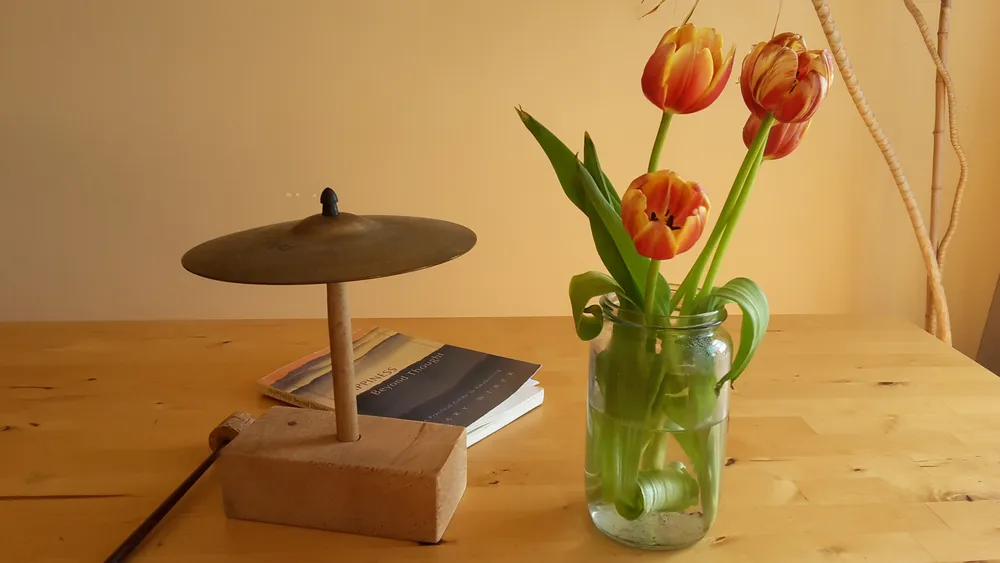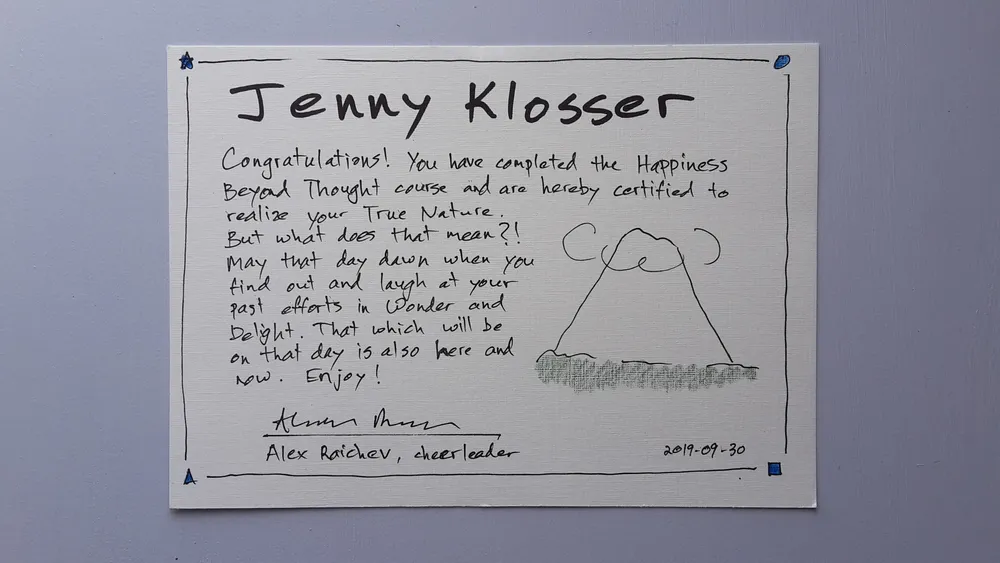Happiness Beyond Thought
A course on withering the personal self.

Description
In this nine-week course we will practice switching off the self-referential internal narrative (SRIN), the mind's press secretary, the feeling of i-me-my, the inner critic, the blah blah blah. This is a good thing, because the SRIN causes all our suffering. Moreover, switching off the SRIN has only upsides, e.g. increased cognitive performance and a sense that all is one and everything is now in an ever-changing dance of wonder and delight. Those are bold claims, and we will test their validity throughout the course.
How to switch off the SRIN? We will proceed kindly and gently with combinations of meditation, self inquiry, posture flows, chanting, negations, and affirmations along the lines of Gary Weber's book Happiness Beyond Thought, which i like.
A persistent shut down of the SRIN may take 10,000 hours of practice, but i bet we will notice benefits within eight weeks.
Format
- Eight weekly 90-minute sessions of instruction, practice, and discussion Mondays 19:00--20:30 at Alex's house
- Bring your own meditation mat and cushion, which you can leave on site
- Daily homework consisting of two 20-minute practices, which is when most of the learning takes place
Teacher
Alex Raichev, keen meditator and talker on the matter, not enlightened but working on it.
Cost
Zero dollars and all your personal attachments.
Resources
- Happiness Beyond Thought by Gary Weber, abbreviated as [Webe2007] herein
- Gary's videos
- Gary's blog
Week 0
Homework
- Find a meditation cushion to bring or a stack of firm pillows
- Find a meditation/yoga mat to bring or a folded blanket
- Download the book and flip through it
Week 1
- Welcome
- Course overview
- Helpful attitudes: curiosity, sensuousness, harmlessness, kindness, patience, persistence, surrender
- Instruction on sitting meditation
- Mat, cushion, clothing
- Posture, one that embodies dignity, erect yet relaxed
- Three pointed questions to set the scene: what am i doing, why am i doing it, what is my attitude?
- Diaphragmatic breathing, unmanipulated
- Focus on the sensations of the rise and fall of the abdomen below the navel, and count exhalations one to ten and back again
- When a story whisks you away, gently label it thinking and return to counting exhalations from one
- Repeat, patiently and persistently. You are training your mind, learning to disentangle yourself from thinking, and that takes practice.
- Questions
- Homework
- Each day do two 20-minutes sessions of sitting meditation (counting exhalations) or one 40-minute session.
- Read the Introduction and Practices A of [Webe2007].
- Each day do one 5-minute session of observing thinking according to one of the practices in Practices A of [Webe2007]. Try them all.
Week 2
- Welcome and sitting session
- Weekly review and questions
- Instruction on walking meditation
- Three questions to start: what am i doing, why am i doing this, what is my attitude?
- Straight path of length ~20 paces
- Go slow and focus on sensations of feet touching ground
- Sync breath with steps, e.g. two steps per in breath and two steps per out breath
- Label thinking
- Repeat, patiently and persistently. You are training your mind, learning to disentangle yourself from thinking, and that takes practice.
- Homework
- Read Practices B of [Webe2007]
- Each day do one 20-minute session of sitting meditation and one 20-minute session of walking meditation.
- One day try one 40-minute session of sitting meditation (and no walking editation).
- Experiment with dropping the counting of out breaths when you feel ettled. Return to counting if you get entangled in thoughts.
- Each day attend to your breath throughout the day.
Week 3
- Welcome and sitting session
- Weekly review and questions
- Instruction on self inquiry. See Practices G of [Webe2007].
- Homework
- Read Practices G of [Webe2007].
- Each day do one 20-minute session of sitting meditation and one 20-minute session of sitting or walking meditation.
- One day try one 40-minute session of sitting meditation.
- Incorporate self inquiry into your meditation sessions, and try self inquiry throughout the day.
Week 4
- Welcome and sitting session
- Weekly review and questions
- Instruction on the Sedona Method
- Allow yourself to feel what you're feeling in this moment
- Could you let it go?
- Assuming you could, would you let it go?
- Assuming you would, when would you let it go?
- Repeat until you feel lighter, freer, and happier.
- Homework
- Read Gary's blog post on the Sedona Method.
- Each day do one 20-minute session of sitting meditation and one 20-minute session of sitting or walking meditation.
- One day try one 40-minute session of sitting meditation.
- Incorporate self inquiry and the Sedona Method into your meditation sessions, and try them self inquiry and the Sedona Method throughout the day.
Week 5
- Welcome and sitting session
- Weekly review and questions
- Instruction on posture flows
- See Practices C of [Webe2007] and Gary's accompanying video.
- If you are interested in qigong, study this diagram and this video.
- Homework
- Read Practices C of [Webe2007].
- Each day do one 20-minute session of sitting meditation and one 20-minute session of posture flows (vinyasas or qigong).
- One day try one 40-minute session of sitting meditation.
- Each day attend to your breath and do self inquiry throughout the day.
Week 6
- Welcome and sitting session
- Weekly review and questions
- Instruction on negations
- See Practices C and Practices H of [Webe2007]
- Homework
- Read Practices H of [Webe2007].
- Each day do one 20-minute session of sitting meditation and one 20-minute session of posture flows (vinyasas or qigong).
- One day try one 40-minute session of sitting meditation.
- Incorporate mindfulness of breathing, self inquiry, the Sedona method, and negations into your meditation, posture flows, and daily life.
Week 7
- Welcome and sitting session
- Weekly review and questions
- Instruction on chanting
- See Practices F [Webe2007] and Gary's accompanying video.
- Homework
- Read Practices F of [Webe2007].
- Each day do one 20-minute session of sitting meditation and one 20-minute session of chanting.
- One day try one 40-minute session of sitting meditation.
- Incorporate mindfulness of breathing, self inquiry, the Sedona method, and negations into your meditation and daily life.
Week 8
- Welcome and sitting session
- Weekly review and questions
- Instruction on affirmations
- See Practices I and M of [Webe2007].
- Homework
- Read Practices I, J, M, N of [Webe2007].
- Each day do one 20-minute session of sitting meditation and one 20-minute session of chanting.
- One day try one 40-minute session of sitting meditation.
- Incorporate mindfulness of breathing, self inquiry, the Sedona method, negations, and affirmations into your meditation and daily life.
- Think about how you would like to integrate the teachings and practices of this course into your daily life after this course ends
Week 9
- Welcome and sitting session
- Weekly review and questions
- Mind map the course
- Integration
- Graduation
- Homework
- Read the rest of [Webe2007]
- Follow your integration plan with patience and persistence
- Check in periodically with me and your cohort
Epilog and Teacher's Notes
All six of us in the first run of the course (ending 2019-09-30) enjoyed our time together. To summarize the feedback i received, everybody liked the teachings, the group discussions and comraderie, and most of the practices, but there was too much material to digest in nine weeks.
So if i were to re-run the course, i'd drastically cut back the material to, say, three practices, or i'd split the course into two or three nine-week courses that build on each other.
Would definitely keep the graduation ceremony, though.
